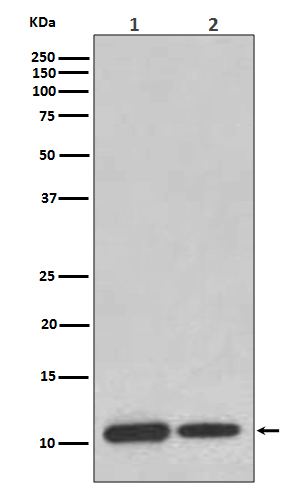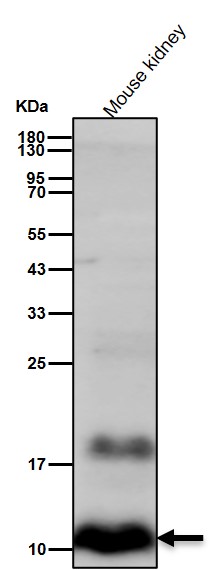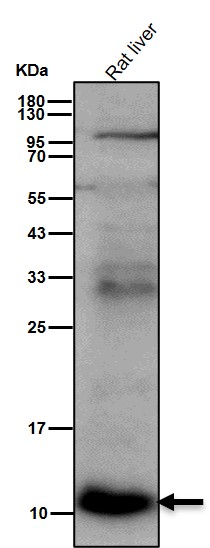


| WB | 咨询技术 | Human,Mouse,Rat |
| IF | 1/20-1/50 | Human,Mouse,Rat |
| IHC | 咨询技术 | Human,Mouse,Rat |
| ICC | 技术咨询 | Human,Mouse,Rat |
| FCM | 1/20-1/100 | Human,Mouse,Rat |
| Elisa | 咨询技术 | Human,Mouse,Rat |
| Aliases | GIF; GLIF; Glycosylation inhibiting factor; L-dopachrome isomerase; MIF protein; MMIF;;MIF |
| WB Predicted band size | 12 kDa |
| Host/Isotype | Rabbit IgG |
| Antibody Type | Primary antibody |
| Storage | Store at 4°C short term. Aliquot and store at -20°C long term. Avoid freeze/thaw cycles. |
| Species Reactivity | Human,Mouse,Rat |
| Immunogen | A synthesized peptide derived from human MIF |
| Formulation | Purified antibody in PBS with 0.05% sodium azide,0.05% BSA and 50% glycerol. |
+ +
以下是关于MIF抗体的3篇文献摘要及作者信息,供参考:
---
1. **文献名称**:*MIF is a pituitary-derived cytokine that potentiates lethal endotoxaemia*
**作者**:Calandra, T., et al.
**摘要**:该研究首次揭示了MIF作为促炎细胞因子在脓毒症中的关键作用,发现垂体来源的MIF可加剧内毒素休克,并表明中和抗体能有效抑制MIF的促炎效应,为靶向MIF的抗体治疗提供了理论基础。
---
2. **文献名称**:*Targeting macrophage migration inhibitory factor in cancer: Therapeutic insights from anti-MIF antibodies*
**作者**:Shimizu, T., & Nishihira, J.
**摘要**:文章综述了MIF在肿瘤生长、血管生成及免疫逃逸中的作用,指出抗MIF抗体可通过阻断MIF与CD74受体结合抑制肿瘤进展,并在黑色素瘤和结直肠癌模型中验证了其治疗潜力。
---
3. **文献名称**:*Structural basis of macrophage migration inhibitory factor (MIF) tautomerase activity inhibition by immunotherapy antibody*
**作者**:Lubetsky, J., et al.
**摘要**:通过X射线晶体学解析MIF蛋白与治疗性抗体的复合物结构,揭示了抗体如何特异性抑制MIF的互变异构酶活性,为开发针对MIF信号通路的高效抗体药物提供了结构生物学依据。
---
如需具体文献链接或补充更多研究,可进一步说明方向(如疾病类型或机制)。
Macrophage migration inhibitory factor (MIF) is a multifunctional cytokine initially identified for its role in inhibiting macrophage migration during immune responses. Discovered in the 1960s, MIF is now recognized as a pleiotropic protein secreted by various cell types, including immune cells, endothelial cells, and endocrine tissues. It plays a critical role in regulating innate and adaptive immunity, inflammation, cell proliferation, and apoptosis. Structurally, MIF exhibits unique tautomerase and oxidoreductase enzymatic activities, though their physiological relevance remains under investigation.
MIF antibodies are tools developed to target and modulate MIF activity in research and therapeutic contexts. In research, these antibodies are widely used to detect MIF expression in tissues or biological fluids via techniques like ELISA, Western blotting, and immunohistochemistry. Therapeutically, anti-MIF antibodies have shown potential in preclinical studies for conditions where MIF overexpression contributes to pathology, such as rheumatoid arthritis, sepsis, atherosclerosis, and certain cancers. MIF's dual role in both pro-inflammatory and immunosuppressive processes complicates therapeutic targeting, as its inhibition may yield divergent effects depending on disease context.
Recent studies highlight MIF's involvement in cytokine storms and metabolic reprogramming of cancer cells, renewing interest in antibody-based strategies. Challenges include optimizing antibody specificity and addressing MIF's complex interactions with receptors like CD74 and CXCRs. Ongoing clinical trials continue to evaluate MIF-targeting biologics for inflammatory and oncological indications.
×